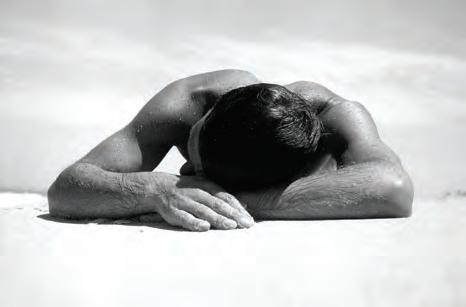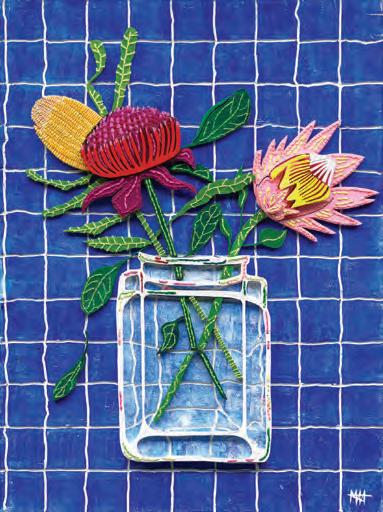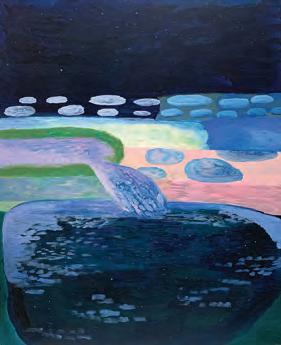
12 minute read
The art on Pymble’s walls
Above Left: Lester’s work lives on in the school grounds with her portrait of former Principal of Pymble Ladies’ College, Gillian Moore, which is on display in Conde Library.
Portrait of Gillian Moore by Kerrie Lester, Oil on Canvas, 153 x 190cm
In background, Portrait of Miss Buckham, by Brian Dunlop, oil on canvas, 100 x 87cm
Top Right: The collection holds a selection of works by Torres Strait Islander artist Billy Missi who was Pymble’s Artist in Residence in 2010. Urapun Kai Buai (Big One Kin) 2007, Ed. of 35, by Billi Missi, linocut printed in black ink from one block, 100 x 250cm on display in the IH Building. A generous gift from a member of the Pymble Community, 2010.
Bottom Right: The Sunbaker, 1937, by Max Dupain, Ed. 72/90, silver gelatin print, 42.5 x 37cm, certificate of authenticity signed by Jill White; On display in the Kate Mason Building
Highlights of the Pymble Art Collection
Along with Pymble’s historical holdings, the collection brings together art from different times and across different cultures. It houses over 50 works of art including considerable pieces by notable figures such as Joshua Smith, Kerry Lester, Mitsuo Shoji, Michael Johnson, Billy Missi and Max Dupain. The collection is funded by small allocations within the school budget, as well as by the generous support of the College community through bequests and donations. The art collection requires significant investment, which makes it worthwhile examining the impact artwork can have in an educational setting. Besides sparking creativity for those working in our classrooms and staffrooms, Pymble’s art collection strengthens our school’s identity, establishes meaningful connections with artists, and is a point of differentiation for the College. The power of art can be diminished if you do not feel a connection to an artwork, and so it is important that our students see their identity reflected on the walls of the school and are inspired by styles of art not often encountered.
Whilst the art collection is a reflection of our school community, there are many stories to tell; and we continue to establish and grow the collection that represents the diversity of Pymble.
KERRY LESTER (1953 - 2016)
Pymble has produced several successful artists. One such artist is Kerry Lester (Alumni, 1971) one of Australia’s most celebrated artists who attended Pymble before studying Fine Art at the National Art School and Alexander Mackie College. Lester, who passed away in 2016, featured regularly in the Wynne and Sulman Prizes and the Mosman Art Prize, which she won in 2011. Best known for her unique hand-stitched canvases, the charismatic artist also worked in print, collage, ceramics and sculpture mediums. Her bold and distinctive portraits were regular contenders for the Archibald Prize and the Portia Geach Memorial Award.
Seeing the work of a successful alumni on display is not only aspirational for students contemplating a career in the visual arts but is also a means of reminding current students of the school’s legacy. The painting is a connection between those sitting in classrooms now and those who were there before them. I often wonder how Lester was inspired by her time at Pymble and how students currently at the College will be influenced by the creativity they see on the walls.
BILLI MISSI (1970-2012)
The Artist in Residence grant, supported by the Pymble Ex-Students’ Union, is yet another way that art can benefit students beyond what they see on the walls. Practicing artists visiting the school bring a unique perspective and are an asset to the Visual Arts education Pymble offers.
Missi is known for his bold and intricate linocut prints depicting his own life experiences and knowledge passed down by Elders. Throughout his 2010 residency, Missi shared his processes of creating art with students and inspiring them to experiment with their creativity. His residency was part of a weeklong Indigenous Cultural Celebration culminating in an exhibition of Indigenous artworks, Sharing Cultures.


MAX DUPAIN (1911-1992)
Within Pymble’s established art collection, we are privileged to have access to the work of artists who have been pivotal in the development of Australia’s cultural identity. One such artist whose work is included in our collection is arguably Australia’s most influential photographers of the 20th century, Max Dupain. Renowned for his black and white photographs, Dupain was a master of light and form and an early proponent of modernist photography. His photographs have become an important historical record of Australian life during the mid to late 20th century. We are incredibly fortunate to house a stunning collection of thirty-one signed and editioned silver gelatin images, most of which are on display in the Kate Mason Building. The collection includes two of his most iconic images and my favourites - The Sunbaker and Bondi, 1939. Each time I encounter these images, I can’t help but appreciate Dupain’s contemporary rendition of time and space, and nostalgically reflect on what these images mean to me personally. These photographs have become, with the passage of time, Australian icons.
COLLECTIONS STRATEGY 2021: ESTABLISHING THE ALISON HALE COLLECTION
Recently, the Ex-Students’ Union Committee, in memory of former Boarder and Ex-Students’ Union President and Secretary, Alison Hale (1926-2018), generously bequeathed funds for new acquisitions to be installed in our boarding houses. Whilst a third of the funds will be used to acquire artworks from Pymble’s alumni art community, consideration was given to the make-up of the College boarding cohort, which has a high percentage of students from regional and rural areas of Australia. This generous gift will be used across two collecting areas; to actively expand the geographical reach of our contemporary art collection and to increase the representation of female artists.
The Alison Hale Collection will consist of an all-female artist line up, celebrating alumni and regional artists, both emerging and professional, which I hope will create a more balanced representation of women artists in the larger collection and strengthen the connection former students have with the College. Every art collection has to start somewhere, and for this one to be initiated by Pymble’s Ex-Student Union Committee proves again how art can play a significant role in building a legacy and creating cross-generational ties.

Natives by Misha Harrison, wool, timber, acrylic, Location: Goodlet House


Antarrengeny, 2020 by Edie Kemarre Holmes, acrylic on cotton, 91cm x 76cm Location: Lang House
Lagoon at Night, 2020 by Ileigh Hellier, oil on linen, 100cm x 80cm Location: Marden House

Current exhibition on display in the David Macfarlane Centre (DMC). Artworks shown from left to right: Dhiyaan (Family) by Shakira Tyson, Year 12 Visual Arts student, 2019; selection of artworks by students working in collaboration with Jason Wing, Artist in Residence, 2019; student works by Olivia Anderson, Kyana Cvetkovic, Aspen Moore, Shakira Tyson, Georgia Stuart, Mika Tyson, Sydney Auld, Mikayla Zahirovic and Kirralee Middleton-Pierpoint & a commissioned artwork titled #3, 2018 by Rheanna Lotter
For those who venture into the boarding houses, expect to see new acquisitions from Alumni artists, Christine Webb and Jessie Breakwell, along with emerging regional New South Wales artists, Misha Harrison and Ileigh Hellier. An artwork by Edie Kemarre Holmes from the Ampilatwatja region, Northern Territory has also successfully been acquired. There are more pieces to come from artists that I hope reflect the identity of those who will be enjoying the works on a daily basis.
As I continue to work on this exciting curatorial project with the Director of Boarding, increasing the representation of female artists around the College is an important focus and one I will continue to advocate for in an all-girls educational environment.
EYE OF THE BEHOLDER: BUILDING ON STRENGTHS OF THE COLLECTION
Regardless of who the primary audience for an artwork may be, any art on display should be reflective of Pymble’s contemporary identity. Our College was founded more than a hundred years ago, and its mission and core values continue to stand strong – All’ Ultimo Lavoro, Strive for the Highest. But over the past century, art and our society have fundamentally changed. This means that our art collection must continue to evolve with our cultural and educational expectations.
New acquisitions and loans showcasing a range of practices across student, emerging, mid-career and established artists can compliment existing historical artworks in the collection. As Curator, I am able to consider what pieces from the collection are on display, how they are shown and in which locations they are exhibited around the College. It is important that the collection doesn’t become stagnant, so a considered rotation of collection artworks together with an annual exhibition program showcasing student work will bring the collection continually to life. This could consist of a series of informed displays across the College as an effective way of ensuring the school’s collection and its history are continually appreciated.
When students and staff move around the grounds of Pymble, I want the spaces they inhabit to be filled with art. Art has the power to educate people about almost anything, and it inspires us to grow and evolve in our understanding of ourselves, each other and the world in which we live. Creativity is becoming an increasingly more essential component within education, and as opportunities for embedding creativity across the curriculum become more urgent, I hope that Pymble’s art collection will spark a broader reflection on the role of art, the kind of art we want to display and, ultimately, what we want to see represented in our College.
Haptic thinking in the Visual Arts classroom
DAVID DEL FAVERO
David Del Favero, Acting Head of Learning Area - Visual Arts, was the successful recipient of the 2020 Pymble Ex-Students’ Union Artist in Residence grant. Along with acclaimed artists, Anne Starling and Rafael Butron, David and our Year 8 Visual Arts teachers, opened a world to students through which their images of and language about their environment found powerful expression in printmaking.
A holistic approach to education recognises that the process of learning in the world is a synthesis of corporeal and cerebral engagement in a diverse range of experiences. Students, children and young people have an invaluable connection to feelings of wellness and wholeness which can be discovered through their exploration of art making. This important aspect of teaching and learning in the visual arts domain is worthy of further exploration through the lens of wellbeing.
Whilst the role of the computer as a classroom tool for learning is highly valued, the immaterial essence of digital engagement has encroached on the sensory ways in which students learn to understand, connect and empathise with their world. The act of physically engaging with matter facilitates a haptic way of thinking that is in danger of being forgotten as students are increasingly immersed in digital technologies. Political and economic imperatives aside, the educational and wellbeing needs of students are enriched when both the mind and body of the individual is developed through meaningful engagement in tactile and sensory learning opportunities.
Haptic: (adjective), relating to the sense of touch, in particular relating to the perception and manipulation of objects using the senses of touch (Definition from Oxford Languages)
The bushfires of the summer of 2019/20 brought close to home the threat of global warming and the urgency for climate change action. Within this context, the Ex-Students’ Union Artist in Residence grant provided opportunities for students to reflect on an issue of personal and global significance and to channel their responses in a positive way through artmaking. Each student’s story, whether experienced or imagined, served as a bridge to connect the individual to her world. Stories also provid material for the healing and creative processes associated with the act of artmaking.
Through the binary relationship of artist and audience, students learned that they could play a meaningful role in raising awareness about issues of global significance and that through individual action, societal change can occur. In the domain of art, an exchange of ideas and feelings takes place between the artist and their audience.
The American philosopher John Dewey argues in Art as Experience (1934/2005) that “the artistic dimension arises from the encounter of the work and its reader/ viewer”. This is because the audience can empathise with the experiences, feelings and ideas that are represented. Could the audience viewing the images produced by Year 8 students feel a sense of responsibility to take action on climate change?
Year 8 Visual Arts students welcomed the Pymble Ex-Students’ Union sponsored Artists in Residence, Anne Starling and Rafael Butron, during Term 3 2020. Both experts in their field, Anne and Rafael generously shared their extensive knowledge of printmaking – dry point intaglio print and lino cut relief.
The artists started the residency with presentations of their art practice in the Jobson Lecture Theatre. Anne Starling’s work explores the relationship between humankind and industry and makes direct reference to the unsettling interstices between the natural and urban environments. Rafael Butron’s art practice celebrates the beauty of nature, as well as examining the human impact on urban and natural landscapes.
The presentations addressed core aspects of the artists’ practice by shedding light on their intentions as well as their choices about subject matter, materials, processes and techniques. The prints displayed to the students were inspirational in motivating them to explore their own response to the theme of climate change.

RESEARCH AND GATHERING AS STIMULUS FOR IDEAS GENERATION
Inspired by the artists’ presentation of their work, students were guided by the artists and their teachers to develop designs for one linocut print and one drypoint print. Encouraged to reflect on their personal response to the fragility of nature, students embarked on their creative journey by brainstorming ideas, researching around the issue of climate change, and gathering stimulus material including text and images. The making of preliminary sketches and annotated notes in their visual arts diaries supported the students’ learning about creative processes.










